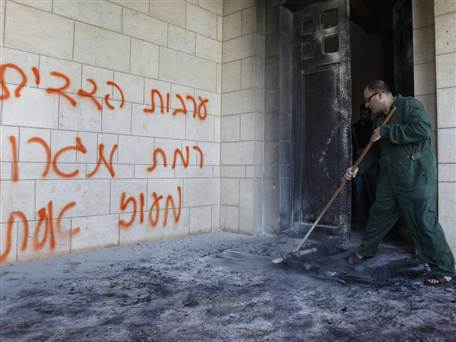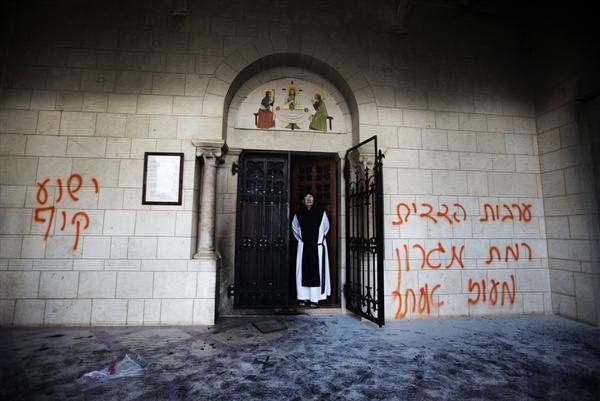"Jesus is a monkey" Jews write on Christian
Monastery wall in Jerusalem


A Trappist monk stands between graffiti reading in Hebrew, "Jesus is
a monkey" (L) and "mutual guarantee,
Ramat Migron and Maoz Ester"
(West Bank settlements) (R), which was sprayed on the wall of the
Latrun Monastery between Jerusalem and Tel Aviv on Tuesday after
unknown people set the monastery's
door ablaze.
'Jesus is a monkey'
daubed on Jerusalem monastery wall
By Alastair Jamieson and wire reports
NBC News, 4 sept 2012
Hebrew graffiti, including the phrase "Jesus is a monkey," was
daubed on the walls of a monastery near Jerusalem early Tuesday in
what police suspect was a so-called 'Price Tag' attack by
right-wing, pro-settler extremists, according to reports.
Vandals torched the wooden door of the Latrun Monastery and
spray-painted the graffiti on the holy site's stone walls, Israeli
police said.
"Police have opened a special investigation into the incident,"
Israeli police spokesman Micky Rosenfeld said.
Israeli security officials had expressed concern about possible
acts of retribution by a suspected settler vigilante campaign known
as 'Price Tag' for Sunday's court-ordered eviction of 50 families
from Migron, a settler site near the West Bank city of
Ramallah. Police believe the incident was part of the campaign,
the Times of Israel and the Jerusalem Post reported.
Rosenfeld said "Migron" and the words "Jesus is a monkey" were
among the phrases scrawled at the monastery, which is located inside
Israel but not far from the occupied West Bank.
'Price Tag' incidents are so-called because the extremists
believe their attacks are extracting a price from
Palestinians
for their action in evicting settlers.
Jerusalem Post
reporter Melanie Lidman
posted pictures
of the graffiti on Twitter.
She
reported that, following the evacuation of Migron on
Sunday, Judea and Samaria District police commander Amos Yaakov
said: "I assume that there will be an increase in 'Price Tag'
incidents, and we have carried out preparations for this."
The attack happened at around 3:30 a.m. local time Tuesday (8:30
p.m. ET Monday) and was quickly discovered by monks, who notified
police, she reported.
The report added that the monastery was a way station for
pilgrims on their way from Jaffa to Jerusalem in the 19th century,
and that the current building was built in 1890.
Reuters contributed to this report.




































